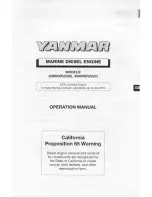
10.3
Section 10
Inspection and Reconditioning
10
Figure 10-2. Removing Plug.
Crankcase
Inspection and Service
Check all gasket surfaces to make sure they are free
of gasket fragments. Gasket surfaces must also be
free of deep scratches or nicks.
Check the cylinder bore wall for scoring. In severe
cases, unburned fuel can cause scuffing and scoring
of the cylinder wall. It washes the necessary lubricating
oils off the piston and cylinder wall. As raw fuel seeps
down the cylinder wall, the piston rings make metal to
metal contact with the wall. Scoring of the cylinder wall
can also be caused by localized hot spots resulting
from blocked cooling fins or from inadequate or
contaminated lubrication.
If the cylinder bore is scored, worn, tapered, or out-of-
round, resizing is necessary. Use an inside micrometer
to determine amount of wear (refer to the
‘‘Specifications, Tolerances, and Special Torque
Values’’, in Section 1), then select the nearest suitable
oversize of 0.08 mm (0.003 in.), 0.25 mm (0.010 in.),
or 0.50 mm (0.020 in.). Resizing to one of these
oversizes will allow usage of the available oversize
piston and ring assemblies. Replacement pistons are
manufactured to precise tolerances. It is not necessary
to "fit" the piston to the cylinder. Start with the new
cylinder bore diameter (from Section 1), add the
desired oversize dimension, and machine the cylinder
to that exact size. The corresponding oversize piston
will then fit the cylinder with the correct running
clearance.
Boring
When over-sizing to 0.25 mm (0.010 in.) or 0.50 mm
(0.020 in.), the initial resizing should be done with a
boring bar, until the cylinder is within 0.08-0.12 mm
(0.003-0.005 in.) of the desired size. Then use the
following procedures for honing to the final dimension.
For 0.08 mm (0.003 in.) oversize, skip the boring bar
and go right to honing.
Honing
While most commercially available cylinder hones can
be used with either portable drills or drill presses, the
use of a low speed drill press is preferred as it
facilitates more accurate alignment of the bore in
relation to the crankshaft crossbore. Honing is best
accomplished at a drill speed of about 250 RPM and
60 strokes per minute. After installing coarse stones in
hone, proceed as follows:
1. Lower hone into bore and, after centering, adjust
so that the stones are in contact with the cylinder
wall. Use of a commercial cutting-cooling agent is
recommended.
2. With the lower edge of each stone positioned
even with the lowest edge of the bore, start drill
and honing process. Move the hone up and down
while resizing to prevent the formation of cutting
ridges. Check the size frequently. Make sure the
bore is cool when measuring.
3. When the bore is within 0.064 mm (0.0025 in.) of
desired size, remove the coarse stones and
replace with burnishing stones. Continue with the
burnishing stones until within 0.013 mm
(0.0005 in.) of desired size and then use finish
stones (220-280 grit) and polish to final size. A
crosshatch should be observed if honing is done
correctly. The crosshatch should intersect at
approximately 23-33° off the horizontal. Too flat
an angle could cause the rings to skip and wear
excessively, too steep an angle will result in high
oil consumption (refer to Figure 10-3).
Flat Washer
Self-Tapping Screw
12345678
12345678
12345678
12345678
Plug
Crankshaft
Summary of Contents for COMMAND CV11
Page 1: ...1 COMMAND SERVICE MANUAL VERTICAL CRANKSHAFT CV11 16 CV460 465 CV490 495...
Page 20: ...2 4 Section 2 Special Tools...
Page 28: ...4 4 Section 4 Air Cleaner and Air Intake System...
Page 54: ...6 6 Section 6 Lubrication System...
Page 109: ...9 15 Section 9 Disassembly 9 Regulating Pin Governor Gear Figure 9 53 Removing Governor Gear...
Page 110: ...9 16 Section 9 Disassembly...
Page 146: ...1 COMMAND SERVICE MANUAL VERTICAL CRANKSHAFT CV11 16 CV460 465 CV490 495...
Page 148: ......
















































